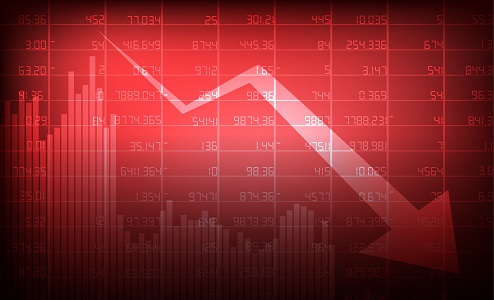Despite August US Consumer Price Inflation (CPI) numbers coming in below expectations on Tuesday, US equity markets broadly failed to catch any respite. The S&P 500 dropped 0.6% yesterday to hit fresh three-week lows under 4450, while the Dow dropped 0.8% to two-month lows and the Nasdaq 100 fell 0.3%. Some analysts framed the larger than expected drop MoM core and headline CPI to 0.1% and 0.3% respectively from 0.3% and 0.5% a month earlier as “taking pressure off of the Fed to press ahead with its QE taper in the coming months”. This is because the slowing of the MoM rate of consumer price gains, on the face of it, seems to endorse the Fed’s view that the spike in inflation in recent months has been transitory. Indeed, looking at the breakdown of the inflation numbers, there is some truth in this; price pressures in areas of the economy that benefitted from reopening earlier in the year (in the hospitality and leisure sector) and that benefitted from the government’s stimulus cheques (used cars) appeared to ease in August. However, the ultimately negative reaction of the stock market on Tuesday suggests that equity investors did not take a “glass half full” view of the report; indeed, evidence is building that rent prices are set to surge, following in the footsteps of the surge in house prices over the last year due to supply shortages and low-interest rates. Moreover, labour market evidence in recent weeks has pointed to increasing wage pressures – last week’s JOLTs data showed job openings at record levels and way above the number of total unemployed persons in the US at the moment. Wage inflation is seen by many economists as a precursor for broad consumer price inflation. Thus, it would probably be accurate to say that fears that the spike in US inflation to well above the Fed’s 2.0% target might be much longer-lasting than the Fed at the moment think, meaning the potential for rate hikes as soon as H2 2022, is one-factor keeping investors cautious. At the very least, yesterday’s inflation numbers seem unlikely to alter the FOMC’s thinking too much regarding QE tapering – this is a key market theme over the coming months and investors will hope the Fed offers some insight into what its QE taper might look like at the September FOMC meeting.
Equity analysts have cited a few other factors as weighing on stock market sentiment in recent days; uncertainty over US tax policy as chatter builds about potential corporation tax hikes and concerns about faltering global growth. These latter concerns were exacerbated by weaker than expected Chinese August activity data released last night; the YoY pace of growth in Retail Sales and Industrial Production both slowed much more than expected in August to 2.5% and 5.3% respectively, sharp drops from the 8.5% and 6.4% growth rates in July. Analysts have cited recent Covid-19 containment related restrictions, a continued shortage of semiconductors amongst other supply chain issues, and output curbs on some of the higher polluting industries (such as steel making) as weighing on the Chinese economy in August – business sentiment surveys (like the Caixin and NBS PMI surveys) released earlier this month painted a similar picture. The August data adds further evidence to the notion that Chinese economic growth has slowed sharply in recent months. Another factor weighing on Chinese growth is an ongoing slowdown in lending (loan data out at the start of the weak confirmed lending growth continued to decline in August). Expectations are growing for the PBoC to try to shore up the economy by boosting lending with further RRR cuts in the coming months. As a result of the soft Chinese data, as well as amid heightened fears about the economic fallout from the impending default of Chinese property giant Evergrande, the tone of Asia Pacific trade was downbeat, with the Hang Seng dropping -1.8% and the Shanghai Comp losing 0.2%.
In terms of markets this morning, European equities are tracking their Asian counterparts lower, with the Stoxx 600 down about 0.4%, while US equity index futures have stabilised overnight, though E-mini S&P 500 futures have so far failed to reclaim the 4450 mark. US 10-year bond yields are back below 1.30% in wake of the softer than expected US inflation numbers, even if the data is unlikely to alter Fed policy-making decisions regarding the QE taper (as the Fed is much more focused on labour market data right now). German 10-year yields are going sideways within recent ranges between the -0.30-0.35% area, with European markets largely unreactive to this morning’s much stronger than expected Eurozone Industrial Production figures for July. Crude oil prices are higher in wake of a much larger than expected draw in crude oil inventories according to the latest weekly Private API inventory report, with WTI prices now comfortably back above the $71.00 level. In terms of FX markets; as a result of recent weakness in global equity markets, and perhaps also due to last night’s poor Chinese economic data, safe-haven currencies JPY and CHF are the two best performers, with the yen about 0.4% stronger on the session versus the buck and the Swiss franc about 0.3% stronger. Indeed, the USD, despite its safe-haven properties, is one of the G10 underperforming currencies this morning alongside the Aussie and Kiwi, which are both performing poorly given concerns about the economic weakness of their most important trade partner China. USD underperformance is likely a result of the drop in US bond yields in wake of yesterday’s US CPI report and the DXY is currently trading around 92.50. But if, as some analysts suspect, the latest inflation figures do not factor into the FOMC’s QE tapering plans and the bank presses ahead with starting to wind down its bond-buying by the end of the year as they have been saying they might, the US dollar might remain a buy on dips.
Finally in FX markets, the euro and pound sterling are both about 0.2% stronger on the session versus the US dollar, as a result of weakness in the later rather than any domestic themes. We have had some key UK data out this morning though; UK inflation numbers were released this morning and the YoY rate of headline CPI posted a record jump in August to 3.2%, 1.2% higher than the YoY rate of CPI in July. The jump was a little larger than expected (median analyst forecasts were for inflation to jump to 2.9% YoY) but has not sent shockwaves through UK markets given that half of the rise can be explained away by one-off price distortions created by government subsidies that came into effect this time last year – this time last year, the UK government implemented the “Eat out to help out” scheme to help the battered restaurant/hospitality sector, which gave consumers a 50% subsidy on restaurant food (up to £10 per person). This artificially suppressed dining costs at the time. Still, the BoE expects inflation to continue to rise into the year-end due to the impact of higher energy prices and pandemic-related supply chain disruptions. The bank has said it expects these effects to be temporary, but with the UK labour market looking increasingly tight (yesterday’s UK jobs data showed a record number of job vacancies in the UK in August), the risk of more persistent inflationary pressures ought not be dismissed.
The Day Ahead
There are no tier one US data releases today, but the release of the September NY Fed Manufacturing survey and August Import and Export price index data at 1330BST will certainly be worth watching, as will August Industrial Production figures at 1415BST. North of the border, Canadian inflation number for August will also be released at 1330BST, while crude oil traders will be watching the latest official EIA inventory report at 1530BST for confirmation of the larger than expected draw shown by last night’s private API report. We then get some ECB speak from Chief Economist Lane at 1600BST, who is likely to sound dovish, as usual. Broadly speaking, the theme of the day will be what the data says about the health of the ongoing US economic recovery.




